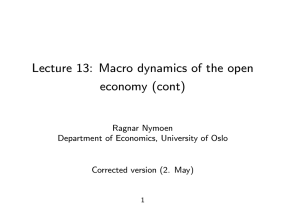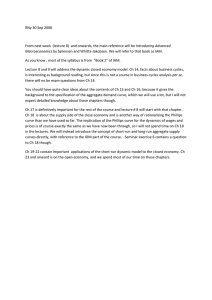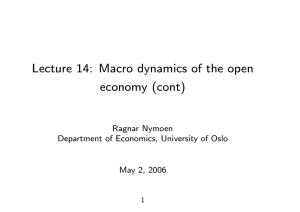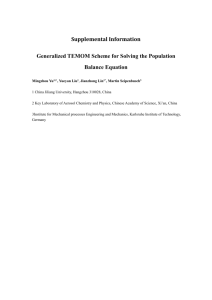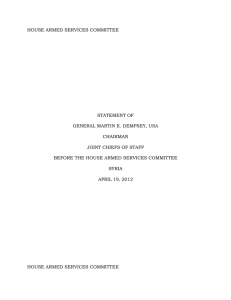Lecture 12 and 13: Open economy AD-AS; Ragnar Nymoen
advertisement
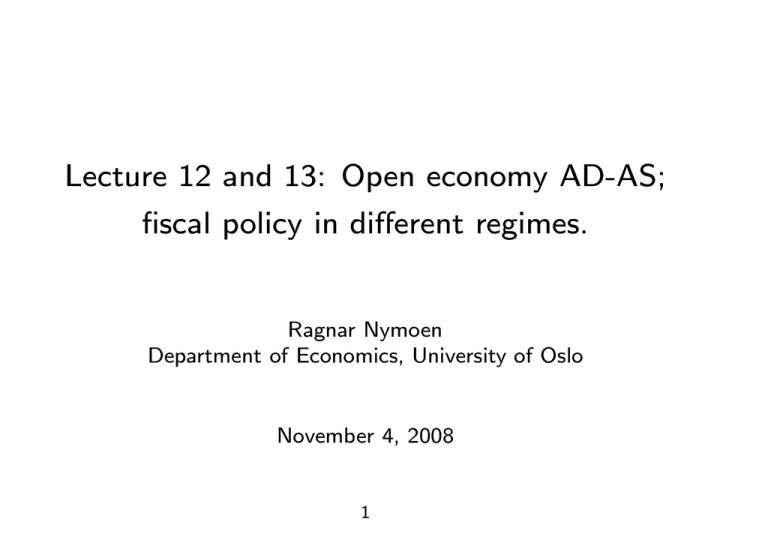
Lecture 12 and 13: Open economy AD-AS; fiscal policy in different regimes. Ragnar Nymoen Department of Economics, University of Oslo November 4, 2008 1 Regime dependent macro models (cont) From Lecture 12 we have the following system of equations: f yt = β0 + β1ert − β2rt + β3gt + β4yt e rt = it − πt+1 f ert = ∆et + πt − πt + ert−1 πt = πte + γ(yt − ȳ) + st f it = it + ee + αe(∆et + et−1) mt − pt = m0 − m1it + m2yt, mi > 0, i = 1, 2 (1) (2) (3) (4) (5) (6) (1) is the product marked equilibrium condition. (2) is the definition of the e is the expected rate of inflation, one period ahead. real interest rate. πt+1 (3) is a definition equation for ert , see IAM, p 704 and 711. (4) is the PCM. e /E ) ≡ ee e e (5) is UIP with ln(Et+1 t t+1 − et = e + α (∆et + et−1) inserted. (6) is an equilibrium condition for the money market. Right hand side is a linearization of the demand for money function. 2 Short-run models f f f In the short-run, the following variables are exogenous: gt, yt , st, πt , it , ert−1, et−1 and pt. Note the discussion at the end of Lecture 10 which motivated the classification of pt as pre-determined (as a simplification). The two main regimes to consider (because the are robust to perfect capital mobility) are Regime I and Regime VI. They are different in terms of how the interest rate is determined. 3 interest rate Ei-curve i1 i0 Money M0 M1 E0 E1 exchange rate Regime I: The shift in the Ei-curve does not affect i. E depreciates Regme VI: To avoid depreciation, i is inceased. Accommodated in the money market by reduction of the money supply (through market operations) Figure 1: Regime I and VI: FEX market and money market equilibrium 4 Regime VI (fixed ex rate, it as instrument) Regime dependent exogenous variable: ∆et. yt πt it n o f r = β0 + β1 ∆et + πt − πt + et−1 n o f f e e e − β2 it + e + α (∆et + et−1) − πt+1 + β3gt + β4yt = πte + γ(yt − ȳ) + st f = it + ee + αe(∆et + et−1) mt − pt = m0 − m1it + m2yt (7) (8) (9) (10) (7) is the AD curve. Note that the equilibrium condition on the market for e , foreign exchange, (9), is included in this equation. (8) is the AS curve. If πt+1 and πte are exogenous, then (7) and (8) determine yt and πt. it is determined in (9) and mt in (10). 5 Regime I (floating ex rate) Regime dependent exogenous variable: mt Money market and FEX market are now interlocked. Solve (5) and (6) for it and the nominal exchange rate: 1 f e) − e (i − i − e t t−1 t αe −1 m m it = (mt − pt) + 0 + 2 yt m1 m1 m1 ∆et = ( ( ) m m 1 f −1 f (mt − pt) + 0 + 2 yt − e (it + ee) + πt − πt + ert−1 − et−1 m1 m1 m1 α ( ) m m −1 e − β2 (mt − pt) + 0 + 2 yt − πt+1 m1 m1 m1 yt = β0 + β1 1 αe f + β3gt + β4yt (11) πt = πte + γ(yt − ȳ) + st (12) 6 The difference between Regime I and VI is the slope of the AD curves (7) and (11): ¯ 1 ∂πt ¯¯ = <0 (13) ¯ ¯ ∂yt AD,rV I −β1 ¯ m2 2 1 − β1 αm e m + β2 m ∂πt ¯¯ 1 1 = (14) ¯ ¯ ∂yt AD,rI −β1 We noted that (14) hinges on αe 6= 0. The interpretation is that with constant depreciation expectations and perfect capital mobility, it is determined by the UIP condition alone. Hence αe = 0 would introduce an internal inconsistency with the assumption that in this regime, mt is exogenous. We ended Lecture 10 by the following important result about the slopes of the short-run AS curves of the two regimes. ¯ ¯ ¯ ∂πt ¯¯ ∂πt ¯ >− , when αe < 0 − ¯ ¯ ∂yt ¯AD,rI ∂yt ¯AD,rV I (15) meaning that the slope of the short-run AD curve is steeper in Regime I than in Regime VI, at least when αe < 0. 7 Interpretation of slope-difference The interpretation of the difference has to do with how the interest rate is determined in the two regimes: When πt increases, y-demand is reduced in both regimes through the real exchange rate, er . But there are additional effects in RI: Lower demand for money reduces the interest rate in the domestic money market. Hence the eventual reduction in y-demand in RI is less than in RVI. This is the same as saying that the slope of the AD curve is steeper in RI than in RVI. ¯ ¯ ¯ ∂πt ¯ ∂πt ¯¯ − >− ¯ ¯ ¯ ∂yt AD,rI ∂yt ¯AD,rV I 8 p Regime VI Regime I y e Figure 2: Short-run AD curves, fixed πt+1 in regime I and VI. 9 The short-run solutions for πt and yt is obtained by solving (11) and (12), for Regime I, and (7) and (8) for Regime VI. To learn about the properties of the two regime versions of the model we will consider the response of the endogenous variables yt and πt. For simplicity, and according to custom, we assume that the initial situation is characterized by πt = π e and yt = ȳ, as depicted in figure 3. 10 p AS pe RVI RI y y e . Regime I and VI. Figure 3: Initial situation with πt = πt+1 11 Fiscal policy in RI and RVI Consider the immediate (short-run) effect of an increase in gt. From (11) and (7), note that for a given yt, the derivative of πt with respect to gt is identical in the two regimes ¯ ¯ ¯ dπt ¯ dπt ¯¯ β3 = = >0 ¯ ¯ ¯ ¯ dgt yt=ȳ,rI dgt yt=ȳ,rI β1 The graphical analysis of short-run effects of fiscal policy is therefore represented by identical vertical shifts in the AD curve of the two regimes. Hence, the impact effect of increased gt is larger in Regime VI (fixed exchange rate) than in Regime I (float), see figure 4. The explanation is that higher GDP output increases the demand for money, which in Regime I increases the interest rate, in regime VI the interest rate stays constant. 12 p AS RVI RI pe y y e Figure 4: Short-run effects of fiscal policy, regime Regime I and VI, fixed πt+1 and πte . 13 Long-run models We still consider Regime I and VI, and repeat the equations of the model: f yt = β0 + β1ert − β2rt + β3gt + β4yt e rt = it − πt+1 f ert = ∆et + πt − πt + ert−1 πt = πte + γ(yt − ȳ) + st f it = it + ee + αe(∆et + et−1) mt − pt = m0 − m1it + m2yt, mi > 0, i = 1, 2 14 (16) (17) (18) (19) (20) (21) The models’ steady-states are defined by the following, see IAM p. 717-719. πte = π̄ f , expectation equal to the world inflation rate yt = ȳ, ert = ert−1 = er , stationarity of rex, gt = ḡ, gov exp on trend, f yt = ȳ f , world GDP on trend ı̄f = constant world interest rate st = 0, no supply shocks Since ert = ert−1 = er and πt = π̄ f it follows from (18) that ∆et = 0 in e /E ) so we add steady-state. It is logical that in a steady-state ∆et = ln(Et+1 t e /E ) = ∆e = 0 ln(Et+1 t t to the list of steady-state conditions. 15 Hence, from the UIP condition (20): i = ı̄f (22) m − p = m0 − m1ı̄f + m2ȳ (23) ȳ = β0 + β1er − β2(ı̄f − π̄ f ) + β3ḡ + β4ȳ f , from AD π = π f , from AS (24) (25) and from (21) e = π̄ f in (16) gives Using i = ı̄f and πt+1 The equations of the long-run model are thus: (24),(25), (22) and (23). The endogenous variables of the long-run model are: er , π, i, m or e, and p. Even though pt is predetermined in the short-run model it is endogenous in the long-run. Hence there is one missing equation in our long-run model. However, note that ert = ert−1 = er is actually the hypothesis of PPP, as a long-run property. Hence, from the definition of er p = e + pf − er 16 (26) which determines p (noting that er is determined in the (24) and pf is exogenous. The PPP condition (26) determines p in the Regime VI, since e is exogenous and fixed. e /E ) = 0 which In regime I, e is determined from the long run condition ln(Et+1 t gives 0 = ee + αee and e in Regime I. Hence, in the long-run model, p is determined by PPP also in Regime I. Hence, m is assumed to be endogenous in the long-run version of regime I. Regime independency of the long-run solution (IAM figure 23.7) (24) is the same in both regimes (I and VI). The long-run AS schedule is also identical across the two regimes. Hence the steady-state solutions for er and π are independent of the two regimes. ¯ r de ¯¯ −β3 = <0 ¯ dḡ ¯rI,rV I β1 17 Hence, if the increase in g is permanent, the model predicts a long-run real appreciation. In both regimes, we can think as if this takes place trough increased P , i.e. using (26). However, as advanced courses on flexible exchange rates will show, the stability of the nominal dynamic adjustment process in regime I is not straight-forward. The dynamics for regime VI is easier to analyze explicitly, and we do that below (at the end of the slide set). 18 e r LR AS LRAD er r e0 y y Figure 5: Long-run effect of fiscal policy, regime Regime I and VI . (Note: the figure illustrates the case of a permanent reduction in gt. ) 19 Summary of AD-AS model for Regime-I and VI. Float/fix Target (exogenous) Instrument short-run effects of g long-run effects of g RI R VI float M i yt and πt ↑, er ↓ er ↓, fix E i larger on yt and πt same as RI 20 Regime dependency of the open economy–so far: We have analyzed the short-run and long-run effects of a permanent change in gt in two exchange rate regimes: Float with money supply as exogenous target variable, and fixed with Et as exogenous target variable and i as instrument. Main conclusions: 1. The regimes can be graphically represented in one graph: the slopes of the AD lines are different. Steeper in the floating ex-rate regime 2. Short-run effect of fiscal policy expansion largest in case of fixed ex-rate regime 3. No long-run effects on y in either regime. The new long run equilibrium level of ert is lower than before the shock. Nominal appreciation in the case of float. Increased P in the fixed exchange rate regime. 21 More on fiscal policy in the fixed exchange rate regime The above is based on fixed and exogenous inflation and a permanent policy change. We now relax these assumptions, and we also want to say something about dynamics. a. Change in gt is permanent and πte and πte are constant Short-run: AD curve shifts. Dynamics: AD curve shift gradually back again. e = πte = π f The economy is “gliding” back to initial equilibrium point (πt+1 and yt = ȳ). Gradually ert is reduced. e = b. As in case a) but inflation expectations are rational in the sense of πt+1 πte = π f , see page 739 in IAM. Same analysis! 22 Formal analysis of dynamics and stability (fixed exchange rate) See 739-741 in ch 24.3 of IAM. So far we have implicitely assumed that the dynamic process which is triggered by the raise in gt is stable, so that a new long-run equilibrium is reached. Intuitively, the dynamics are in fact stable, since a process of real currency appreciation begins as a result of the shock. As an exercise, this can be shown formally. Fixed ex-rate assumptions: e πt+1 = πte = π f eet+1 − et = 0 ∆et = 0 23 The model can be written in somewhat more compact form as f yt − ȳ = β̂0 − β1(πt − πt ) + β1ert−1 + β3gt + dt, f f f dt = −β2(it − πt ) + β4yt − ȳ f πt − πt = γ(yt − ȳ) + st f ert = −(πt − πt ) + ert−1 (27) (28) (29) Use (27) and (28) to express for ert−1 by yt − ȳ (e.g. by substitution for f (πt − πt )): ert−1 = 1 β dt β̂ (1 + β1γ)(yt − ȳ) + st − 3 gt − − 0 β1 β1 β1 β1 which is equation (14) on page 739 in IAM. We also have: ert = 1 β d β̂ (1 + β1γ)(yt+1 − ȳ) + st+1 − 3 gt+1 − t+1 − 0 β1 β1 β1 β1 Using these two expressions in (29), together with (28), gives the following 24 ADL model for (yt+1 − ȳ): 1 β3 (yt+1 − ȳ) = (yt − ȳ) + ∆gt+1 + .... 1 + β1γ (1 + β1γ) or, for yt : (yt − ȳ) = 1 β3 (yt−1 − ȳ) + ∆gt + .... 1 + β1γ (1 + β1γ) (30) We can now apply what we have learnt about stability earlier, namely that (yt − ȳ) is dynamically stable if 1 <1 1 + β1γ which holds since β1γ > 0. 25 Temporary versus permanent fiscal policy shocks (IAM p 24.3) We can also use (30) to analyze the different responses to permanent and temporary fiscal policy shocks. A permanent shock amounts to ∆g1 > 0, for example ∆g1 = 1, and ∆g2 = ∆g3 = ... = 0. A temporary shock amounts to ∆g1 = 1, ∆g2 = −1, for example, and ∆g3 = 26 ∆g4 = ... = 0. perm temp impact β3 (1+β1γ) β3 (1+β1γ) 2nd β3 (1+β1γ)2 −β1γβ3 (1+β1γ)2 3rd β3 (1+β1γ)3 −β1γβ3 (1+β1γ)3 ... 0 ... 0 Hence the temporary leads to a short expansion, and then a longer period where yt − ȳ < 0. So far we have considered unsystematic fiscal policy, An example of systematic fiscal policy is: gt − ḡ = a(ȳ − yt), 27 a > 0. (31) Intuitively, in this model, systematic fiscal policy leads to a steeper short-run AD schedule. A real appreciation leads to less reduction in y in the case of a > 0, than a = 0, see fig 24.4. Effects of negative demand shocks are smothered. The speed of adjustment is reduced. 28 Inflation targeting in the AD-AS model The different regimes explained in Lecture10 and 11 Foreign exchange rate market exogenous variable Foreign exchange reserves Exchange rate Money market Money supply exogenous Interest rate variable None I III V II IV VI R-I is a a so called money targeting regime, we have compared it to the R-VI (Et is targeted) In R-I the instrument of monetary policy is market operations: buying and selling of domestic bonds controls the supply of money in the domestic money market. 29 Recall the “supply of money function” of the open economy: ∆Mt = −∆Bt + Et · ∆Fg,t + ∆Et · Fg,t In R-I ∆Fg,t = 0 and Fg,t = F̄g . Revaluations of the stock of foreign currency F̄g affects ∆Mt somewhat, but according to the theory of R-I, such movements are countered by market operations (∆Bt). Changes in the net supply of bonds can also be used to increase or lower Mt independently of the market for foreign exchange. Hence, monetary policy independence in R-I: the interest rate is determined on the domestic money market. No such independence in R-VI, because the interest rate is determined in the market for foreign exchange. Remember that the discussion of R-I and R-IV was based on the assumption of perfect capital mobility (as in the IAM book). 30 Why consider alternatives to R-I? A full discussion is beyond this course, but in practice R-I failed to live up to the expectations founded in the theory just summarized: It turned out to be difficult to control money supply. Two issues in particular seem to have been important: a) Which money stock measure to target (M1, M2 or M3) b) In practice central banks rode two horses: tried also to intervene in FEX market (dirty float), which affect money supply In any case, R-I was really never considered an alternative when several SOEs started floating their exchange rates in the 1990’s. The alternative most countries settled for is called inflation targeting. In our typology inflation targeting can be seen as an extension of R-III. The interest rate is the used as an instrument to achieve a certain inflation rate (the target). Therefore, it is “exogenous in the domestic money market”. However it is endogenous in the wider setting of our macroeconomic model. We now define the inflation targeting regime 31 Inflation targeting defined We make a short-cut and replace equation (2), page 769 in IAM with the following policy response (equivalent to what IAM also eventually ends up with) f it = it + h(πt − π ∗) h > 0. (Policy response) where π ∗ denotes the inflation target, usually a number like 2% or 2.5% (annual rate). f Note: could have coefficient different form 1 in front of it as well. Remark to table 25.1: Norges Bank does not acknowledge that it operates with “tolerance bands”. Rather a horizon (1-2 years) over which the target should be achieved. 32 We follow IAM and make the following simplifying assumption π ∗ = π̄ f , target set to the constant foreign inflation From policy response function and expectations: f it = it + h(πt − π̄ f ) which is eq (14) on page 776. We can now augment the AD-AS model with this ’policy rule’. 33 f yt = β0 + β1ert − β2rt + β3gt + β4yt e rt = it − πt+1 f ert = ∆et + πt − πt + ert−1 πt = πte + γ(yt − ȳ) + st f it = it + ee + αe(∆et + et−1) αe < 0 f it = it + h(πt − π̄ f ) mt − pt = m0 − m1it + m2yt, mi > 0, i = 1, 2 (32) (33) (34) (35) (36) (37) Note that (35), is a generalization of eq (9) on page 771. IAM omits ee and et−1, and αe corresponds to −θ in IAM. Skip the discussion on p 772 and 774, it represents an internal inconsistency (non zero risk-premium and dirty float even though perfect capital mobility here). Compared to R-I we have one more equation. Hence mt is endogenous in the short-run model of inflation targeting 34 The short-run analysis (inflation targeting) From (35): 1 f ∆et = e (it − it − ee) − et−1 α substitution of it from (36) −1 f 1 f e) − e f )) (i + e + (i + h(π − π̄ t t−1 αe t αe t 1 = e (h(πt − π̄ f ) − ee) − et−1 α We therefore obtain the short-run AD schedule from ½ ¾ 1 f f ) − ee) − e r yt = β0 + β1 (h(π − π̄ + π − π + e t t t−1 t−1 t e α n o f f f e − β2 it + h(πt − π̄ ) − πt+1 + β3gt + β4yt ∆et = 35 (38) (39) We adopt IAM’s assumptions about inflation expectations: e πt+1 = πte = π ∗ = π̄ f hence the model becomes ½ ¾ 1 f f ) − ee) − e r yt = β0 + β1 (h(π − π̄ + π − π + e t t t−1 t−1 t e α n o f f f f − β2 it + h(πt − π̄ ) − π̄ + β3gt + β4yt (40) and πt = π̄ f + γ(yt − ȳ) + st Differentiate (40) to obtain the slope of the R-III short-run AD-curve: ¯ ∂πt ¯¯ −1 = <0 ¯ β ¯ 1 ∂yt AD,rIII β1 + h(β2 − αe ) consistent with β̂1in eq. (15) on page 776 in IAM. 36 (41) ¯ ¯ ¯ ∂πt ¯ ∂πt ¯¯ − >− , when αe < 0 ¯ ¯ ∂yt ¯AD,rV I ∂yt ¯AD,rIII ¯ ¯ ¯ ∂πt ¯¯ ∂πt ¯ >− , when αe < 0 − ¯ ¯ ∂yt ¯AD,rV I ∂yt ¯AD,rIII hence the short-run AD schedule is flatter in R-III (inflation targeting) than in R-VI. 37 Inflation πf R−III R−VI R−I ȳ 38 Real GDP Interpretation of slope-difference The interpretation of the difference has to do with how the interest rate is determined in the two regimes: When πt increases, y-demand is reduced in both regimes through the real exchange rate, er . But there are additional effects in R-III: The interest rate is increased (monetary policy response) which leads to further reduction in yt. Hence regime III is different from the fixed exchange rate VI, but also from the floating exchange rate regime I (money as the target) where lower demand for money reduces the interest rate in the domestic money market. We have generalized figure 25.3: AD(flex) represent only one sub-category of floating exchange rate regimes. 39 Short-run effect of a supply-shock Consider a positive aggregate supply shock in period t = 1, s1 < 0 (s0 = 0) The impact multipliers: GDP: largest for R-III, smallest for R-I. Inflation: Largest reduction for R-I, smallest reduction for R-III. The fixed exchange rate regime (R-VI) is an intermediate case. If h → ∞ R-III multipliers approach R-VI multipliers (not R-I). 40 Long-run effects of a supply-shock If the reduction in s is temporary: no long run effects. π − π̄ f = 0 from AS (the Phillips curve). Then er = er0 from definition of real-exchange rate. If a permanent reduction of s, then apparently π − π̄ f = s1 < 0 which cannot be reconciled with e = πte = π ∗ = π̄ f πt+1 Paradox is resolved by nothing that ȳ is increased by the permanent positive supply shock. The natural rate of unemployment is lowered. So π − π̄ f in the long-run as before. But for higher ȳ. 41 Short-run effects of a demand shock Use fiscal policy again to represent a demand shock. We already know that R-I and R-VI can be compared by (identical) vertical shifts of the AD curve: However, from (40) ¯ ¯ ¯ dπt ¯¯ β3 dπt ¯ = = >0 ¯ ¯ dgt ¯yt=ȳ,rI dgt ¯yt=ȳ,rV I β1 ½ 1 f f ) − ee) − e r yt = β0 + β1 (h(π − π̄ + π − π + e t t t−1 t−1 t e α n o f f f f − β2 it + h(πt − π̄ ) − π̄ + β3gt + β4yt we see that ¯ dπt ¯¯ β3 = ¯ β1 dgt ¯yt=ȳ,rIII β1 + h(β2 − α e) ¾ so (unless the trivial case of h = 0) a vertical shift are not comparable (IAM p 782) 42 However, note that for a given π: ¯ dyt ¯¯ = β3 ¯ ¯ dgt πt=π̄,rIII since there are no indirect demand side effects of a change in y in this regime (yt is not included in the policy response function). The same is true in R-VI where the interest rate is determined on the FEX marked. Hence, from n we have o f r yt = β0 + β1 πt − πt + et−1 n o f f e e e − β2 it + e + α (∆et + et−1) − πt+1 + β3gt + β4yt ¯ dπt ¯¯ = β3 ¯ ¯ dgt πt=π̄,rV I hence, we can make a comparison of regime III and VI with the aid of a horizontal shift of the AD schedule. See IAM p 782 for the algebraic analysis. 43 The impact multipliers (of a change in gt): GDP: larger for R-VI than for R-III. Inflation: larger for R-VI than for R-III. Hence there is no clear cut answer to which monetary policy regime give most automatic stabilization to shocks. Relative frequency of demand and supply shocks is one aspect. This theme is developed further in IAM ch 26.1-26.2, in different directions, which we leave for self-study. 44 Choosing the rate of inflation Sometimes the message is communicated that inflation targeting is not only about stabilization, but also about “choosing a different rate of inflation than the foreign rate”. In the model, such a policy choice entails keeping π ∗ as a policy determined parameter in the interest rate response function. The steady-state consistent with π = π ∗ and a constant real exchange rate, now implies that ∆e = (π ∗ − π f ), so (π ∗ − π f ) > 0 in the steady-state implies a constant rate of nominal depreciation. 45
